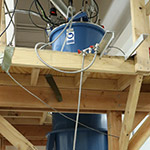Physicists Practice ‘Spin Control’ to Improve Information Processing
Currently, information-processing tools like computers and cell phones rely on electron charge to operate. A team of UC San Diego physicists, however, seek alternative systems of faster, more energy-efficient signal processing. They do this by using “excitons,” electrically neutral quasiparticles that exist in insulators, semiconductors and in some liquids. And their latest study of excitonic spin dynamics shows functional promise for our future devices.










